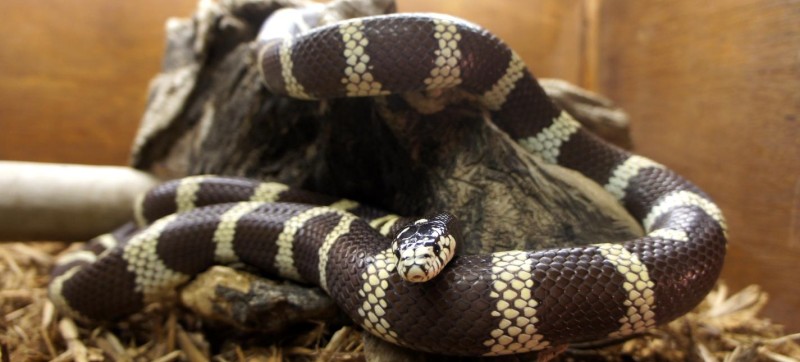California King Snake - Lampropeltis getulus californiae

Habitat:
desert, woodlands, chaparral, farmland, river bottoms, grasslands, deciduous and coniferous forests
Range:
West coast of N. America, from tip of Baja to Southern Oregon. W. Coast of California to Nevada and Arizona
Activity Cycle:
most active when hungry or agitated
Features:
brown and yellow in color
Size:
Weight: up to 2 pounds: Length: 30 to 70 inches long (2-3 inches is the tail)
Social Structure:
are usually solitary creatures, except when they hibernate
Life Expectancy:
12 to 15 years and up to as long as 20 yrs
Diet:
Diet in the wild: rodents, birds, lizards, frogs, snakes
Status:
IUCN lists California kingsnakes as "least concern".
Interesting Facts:
- has bad eye sight due to positioning of eyes on sides of head. But does have good close-up vision.
- It was once thought that these snakes were immune to venom. They are not but have a tolerance for it.
- Kingsnake’s jaws are hinged and allow them to swallow prey larger than their head.
- They have a tolerance for rattlesnake venom, unless a large dose is injected into the head or heart of the kingsnake, death may occur.
- Has a spine consisting of 100-400 vertebrates and each is attached to a pair of separate thin ribs. This allows them to climb and move in an S shape.
- The King snake can hear low frequency sounds and feel vibrations. This enables them to sense approaching animals before they reach the area where the snake is.
- The Jacobson’s organ and the snake’s fork shaped tongue allow the snake to smell its environment.
Prices
- Adult (13 and over)$12.50
- Child (2 - 12)$9.00
- Child (1 and Under)FREE
- Senior (65+)$11.50
- Active Military$11.50
We begin transferring animals to evening (off exhibit) holding at 4:30 each night.
Find Us
2320 N. Prospect Rd.
Peoria, IL 61603
Phone: 309-686-3365
Open Daily 10:00-5:00
Last admission at 4:30
